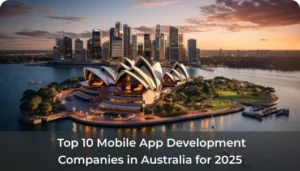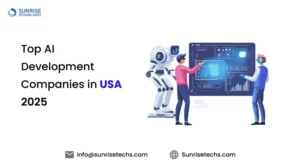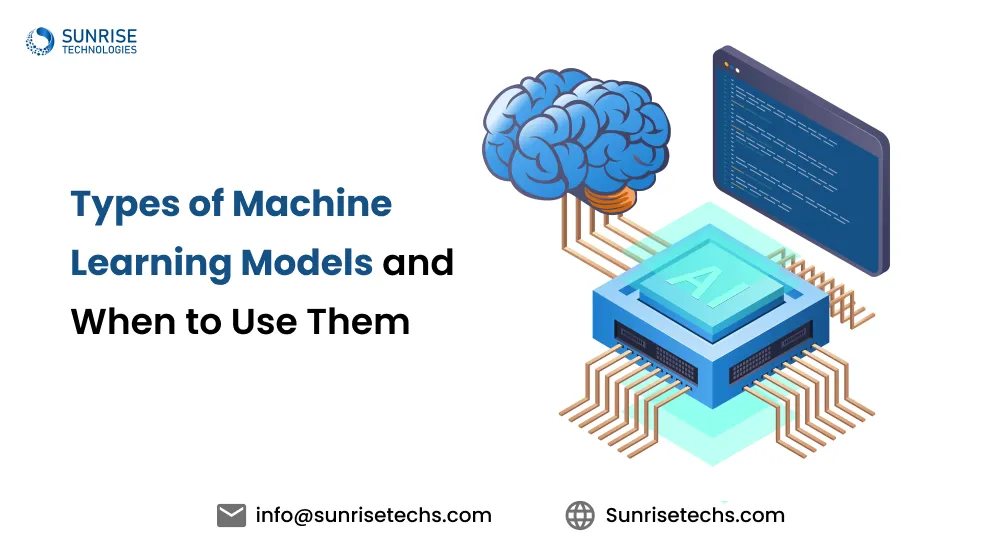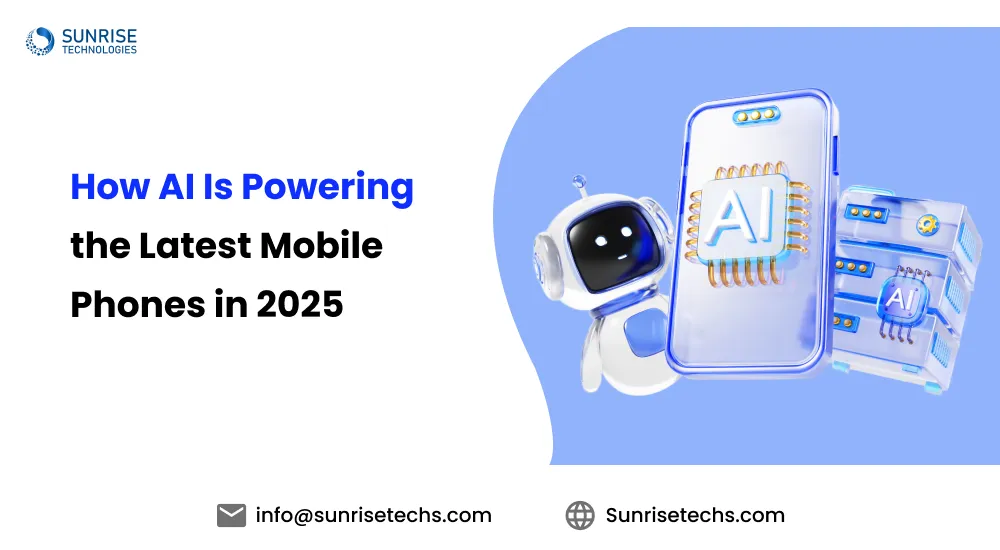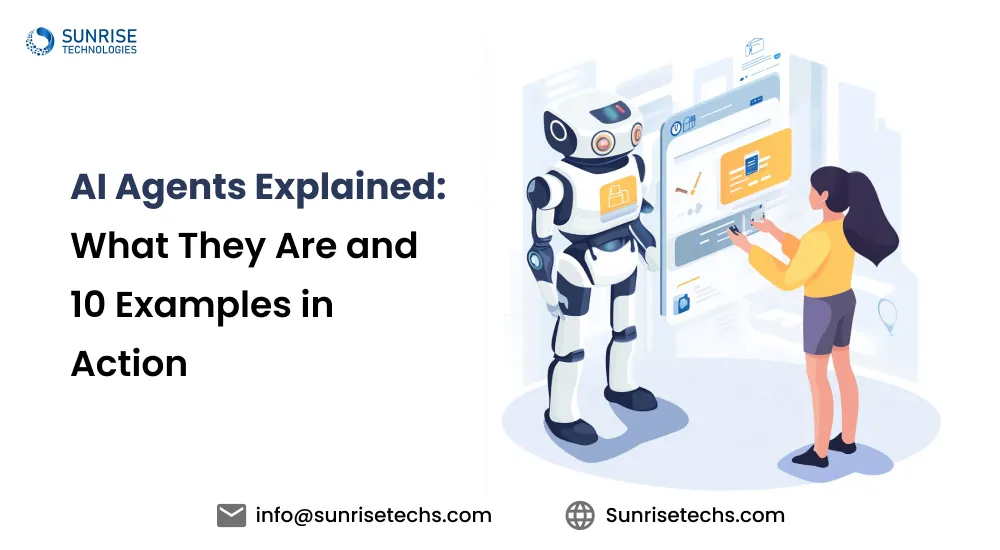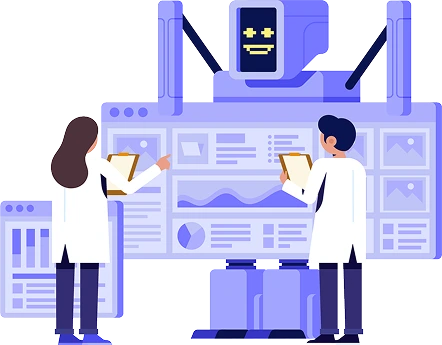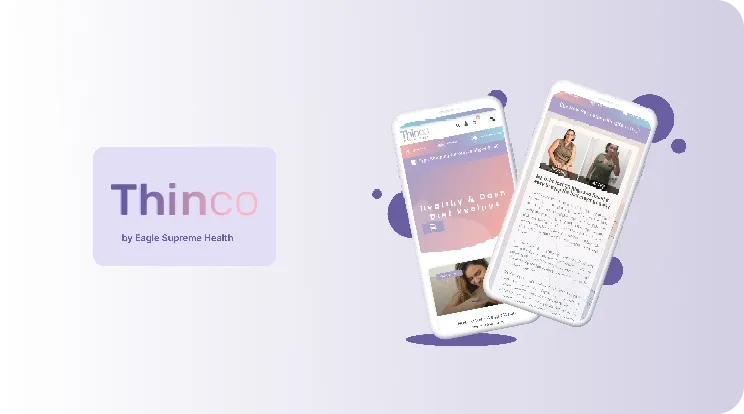How Businesses Are Using Generative AI to Innovate in 2025
May 21, 2025
Generative AI has rapidly moved beyond the buzz to become a core business enabler, fueling hyper-personalized marketing, automating multi-channel customer support, and even optimizing supply chain operations through synthetic data generation and AI-driven forecasting models. Companies across industries are now harnessing its power not just to save time, but to create entirely new value streams.
As we stepped into 2025, the impact of generative AI is scaling fast, streamlining workflows, driving innovation, and enhancing decision-making across the enterprise. Curious how it all comes together in the real world? Let’s explore the cutting-edge use cases, strategic benefits, and industry trends, and discover how custom generative AI development services can help you build intelligent systems that don’t just react, but anticipate.
How Is Generative AI Impacting the Global Economy?
Generative AI is experiencing unprecedented growth in 2025, with projections indicating substantial market expansion. Here are three key statistics highlighting this trend:
The global generative AI market is projected to grow at a CAGR of 34.2% from 2023 to 2030, driven by healthcare, retail, and automotive adoption.
Generative AI attracted $33.9 billion in private investment globally in 2024, marking an 18.7% increase from the previous year. .
The global generative AI market is forecasted to reach approximately $1.005 trillion by 2034, growing at a CAGR of 44.20% from 2025 to 2034..
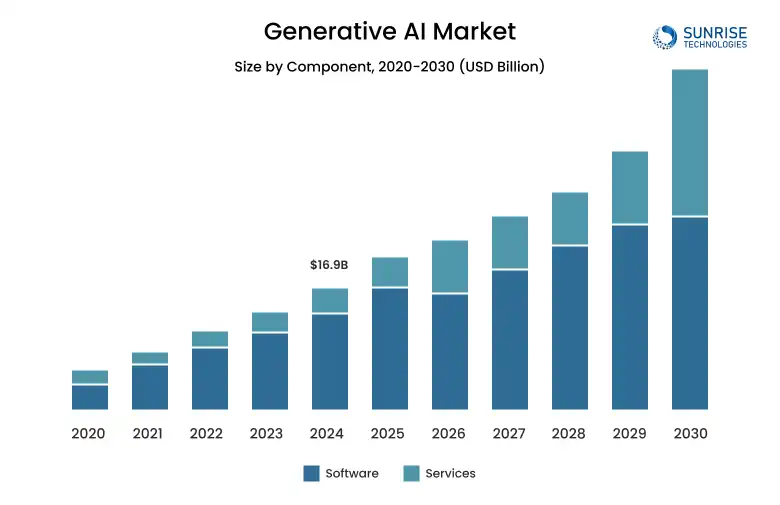
Image title: Skyrocketing Growth: Generative AI Market on Track for Explosive Rise by 2030
What is Generative AI and What Can It Do?
Generative AI is a subset of artificial intelligence that leverages machine learning models, especially deep learning and neural networks, to create new content. This content can range from text and images to audio, video, and even code. At its core, generative AI models learn patterns from vast datasets and use this knowledge to generate outputs that resemble human-created content.
Technically speaking, generative AI development often relies on complex deep learning models, Generative Adversarial Networks (GANs) and Transformer networks. GANs involve two AI models competing against each other, one trying to generate realistic fake data, and the other trying to distinguish it from real data, pushing each other to get better and better. By implementing generative AI, businesses have reduced content creation time by 60% and boosted customer engagement by 2.5x, showcasing the tangible benefits of this technology.
- Marketers can auto-generate ad copy tailored to audience segments.
- Customer support teams can use AI chatbots that learn from every interaction.
- Developers can co-code with AI tools like GitHub Copilot.
- Designers can create product prototypes in minutes using AI design tools.
Types of Generative AI Models Unveiled

Generative AI is like a master creator, but behind that creative power are different types of AI models, each trained using unique techniques and architectures.
Ever seen AI create ultra-realistic faces or deepfakes? That’s GANs at work. GANs use two neural networks, the generator and the discriminator, playing a game of “fool me if you can.” One creates data, the other tries to detect if it’s fake. They improve together until the output is shockingly realistic.
Use case: Image generation, fashion design, art, and synthetic data creation.
VAEs take complex data, like an image or sentence, shrink it into a latent space (a compact mathematical format), and then reconstruct it. While not as “photo-perfect” as GANs, VAEs are more stable and useful for data exploration and generation.
Use case: Medical imaging, anomaly detection, and image denoising.
These are the wordsmiths of generative AI. Transformers use a mechanism called attention to understand context and generate coherent text, code, or even music. They’re what power models like ChatGPT, PaLM, and Claude.
Use case: Content creation, summarization, chatbots, auto-coding.
These models start with noise (literally!) and gradually turn that chaos into detailed images. It’s like watching fog lift and reveal a beautiful landscape. Models like DALL·E 3 and Stable Diffusion use this approach for high-resolution, creative image generation.
Use case: AI art, visual storytelling, concept design, marketing assets.
Autoregressive models generate data one step at a time, using the previous outputs to predict the next. Think of it like building a sentence word by word. GPT models fall under this umbrella too.
Use case: Text generation, time-series prediction, auto-completion.
These are lesser-known but powerful. They transform complex distributions into simpler ones and vice versa, allowing them to generate realistic data with exact probability values, which is great for scientific modeling.
Use case: Statistical modeling, physical simulations, structured data generation.
Unimodal models are trained to understand and generate a single type of data—just text, just images, or just audio. They’re laser-focused on one format, making them incredibly efficient in their specialized domain. For instance, GPT-2 is a unimodal model that works only with text.
Use case: Text summarization, speech-to-text, image classification.
These models are the multitaskers of the AI world. Multimodal models can process and generate across multiple data types, like combining text and images or video and audio. They understand the relationship between formats, enabling more human-like comprehension and creativity.
Use case: Text-to-image generation, AI assistants that see and talk, video captioning.
LLMs are massive neural networks trained on vast corpora of text data. They learn the nuances of language, context, and semantics to generate text that feels surprisingly human. These models often use transformer architectures and are capable of zero-shot and few-shot learning.
Use case: Conversational AI (like ChatGPT), automated content creation, semantic search.
NeRFs are a newer class of generative AI that focuses on 3D scene reconstruction using 2D images. They encode how light interacts with surfaces and objects to generate photo-realistic 3D environments, ideal for gaming, AR/VR, and simulations.
Use case: 3D modeling, virtual tours, immersive AR/VR environments.
Benefits of Integrating Generative AI into Business Operations
Generative AI isn’t just futuristic hype, it’s a set of powerful neural network architectures and machine learning algorithms that are transforming business workflows, one automation at a time. From natural language processing (NLP) to multi-modal models, here’s how it’s reshaping the enterprise world:
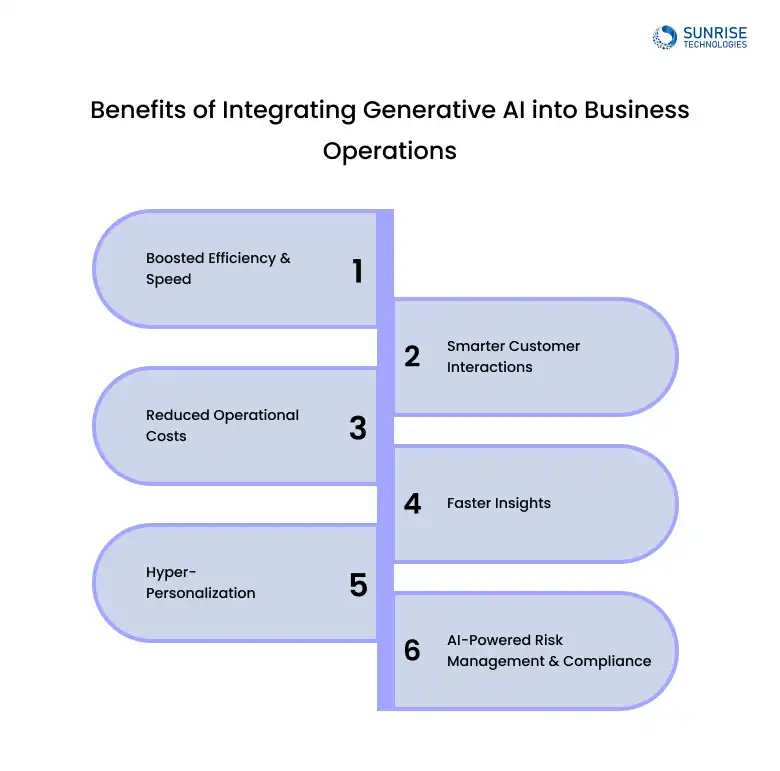
Generative AI models, especially transformer-based architectures like GPT or BERT, are brilliant at automating text-heavy processes. These models can generate human-like content, summarize documents, and even handle legal or HR documentation at scale. Using fine-tuned language models, businesses are generating SEO content, product descriptions, and emails automatically.
By leveraging NLP and intent recognition algorithms, AI-powered chatbots and virtual agents can understand customer queries in context and respond with human-like accuracy.AI chatbots trained with reinforcement learning improve over time through feedback loops, enhancing customer support without needing 24/7 staffing.
Generative AI enables businesses to simulate, forecast, and optimize processes using advanced models like diffusion models or GANs (Generative Adversarial Networks) for everything from logistics to finance.According to Gartner, 50% of finance teams are using AI-driven forecasting models to reduce budget planning costs by up to 40%.
With AI models that synthesize large datasets, businesses are generating real-time reports and predictive analytics dashboards using generative BI (business intelligence) platforms. Companies now feed raw data into pre-trained LLMs (Large Language Models) like Claude or GPT-4 to auto-generate reports, insights, and even investor presentations.
Using multi-modal AI models (which combine text, image, audio), businesses are delivering ultra-targeted experiences to users across channels. Retailers employ vision-language models to suggest products by analyzing user interactions, preferences, and even uploaded photos, dramatically improving conversion rates.
Generative AI models are also helping with regulatory compliance by auto-generating audit trails, identifying anomalies using unsupervised learning, and flagging risks in real time.Banks are deploying AI models for KYC document validation and fraud detection, powered by sequence-to-sequence models and anomaly detection algorithms.
What Type of Content Can Generative AI Create?
Generative AI has quickly become a creative ally for businesses, helping them move faster, work smarter, and scale their content production effortlessly, and its real strength lies in the variety of content it can generate.
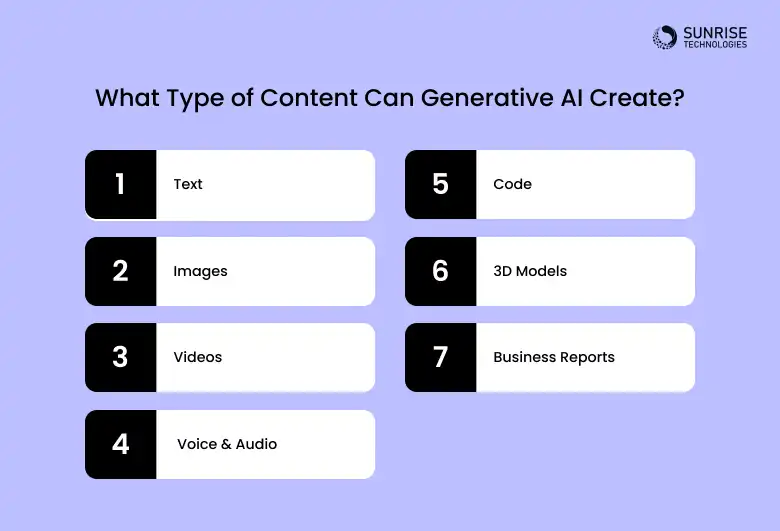
Generative AI excels at producing high-quality, human-like text content. Whether it’s personalized emails, blogs, ad copy, or product descriptions, these models understand tone, context, and structure, allowing businesses to scale content creation without compromising quality.
Ideal for: Marketing automation, SEO content, customer service responses, and internal documentation.
AI-generated images are revolutionizing visual content. By translating text prompts into graphics, logos, mockups, or illustrations, companies can reduce design turnaround time and maintain brand consistency at scale.
Ideal for: Digital marketing assets, product visualization, brand creatives, and rapid prototyping.
From scriptwriting to animated visuals and AI voiceovers, generative models assist in video content creation. These tools empower teams to develop promotional videos, tutorials, and product demos with significantly less effort.
Ideal for: Explainer videos, e-learning modules, and personalized video ads.
Generative AI can synthesize realistic voices and even generate background music or sound effects. It supports multilingual content delivery and branding through custom voice tones, creating new efficiencies in media production.
Ideal for: Voice assistants, podcasts, IVR systems, and multilingual content generation.
AI-assisted development tools like GitHub Copilot use generative models to write code snippets, debug functions, and suggest logic in real-time, boosting developer productivity and accelerating deployment cycles.
Ideal for: Software development, rapid prototyping, and automated testing.
Generative AI can build immersive 3D environments and objects for virtual applications. This capability is critical in industries where realism and simulation are key, such as gaming, architecture, and retail.
Ideal for: Game design, product prototyping, AR/VR experiences, and virtual staging.
AI models can read structured and unstructured data to generate summaries, dashboards, and analytics reports. They offer decision-makers real-time insights and eliminate the burden of manual reporting.
Ideal for: Financial reporting, performance tracking, market research, and BI automation.
How Startups industries are Using Generative AI for Business in 2025
Generative AI is being actively adopted across industries to streamline operations, boost creativity, and unlock new growth avenues
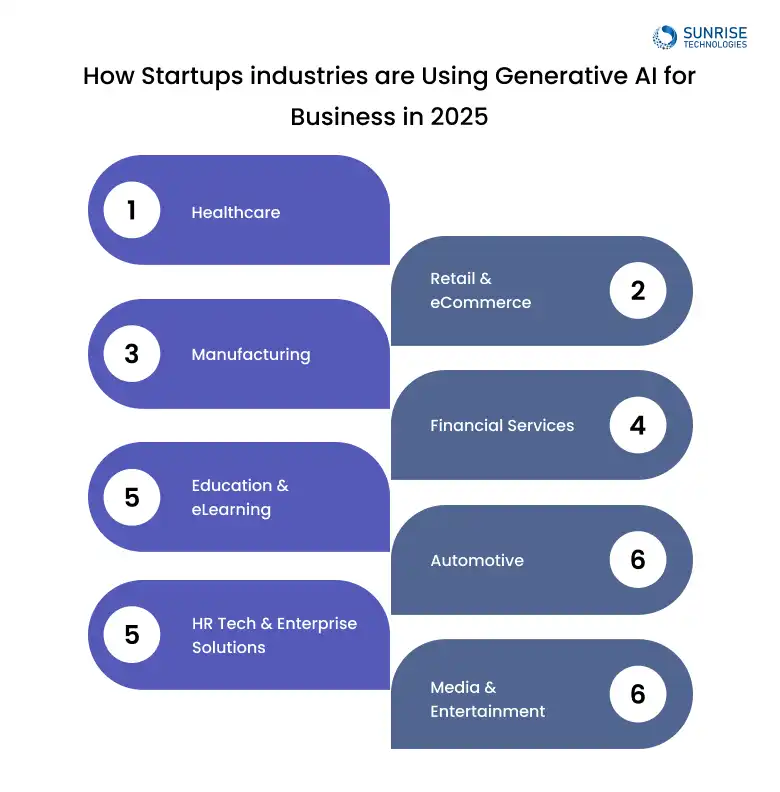
Generative AI in healthcare supports everything from clinical documentation to patient engagement. It’s enabling faster diagnoses, auto-generated medical summaries, and conversational agents that handle appointment scheduling and symptom triage, while complying with HIPAA standards.
Generative AI for Retail to hyper-personalize customer experiences. From AI-generated product descriptions to real-time promotional campaigns tailored to shopper behavior, the tech is reshaping how consumers discover and interact with products.
Generative AI in manufacturing is redefining design, production, and predictive maintenance in manufacturing. Engineers can now use AI to create digital twins, simulate stress tests, and optimize product designs automatically, reducing time-to-market and production costs.
Institutions are automating and securing their processes using generative AI for finance. From summarizing complex compliance documents to generating personalized financial advice, AI is making financial services more accessible and efficient.
Education systems are adopting generative AI to make learning more engaging and customized. It’s enabling content generation tailored to individual learning styles, automated grading, and even AI tutors for one-on-one support.
In the automotive world, generative AI is used in both design and post-sale support. It powers intelligent voice interfaces, predictive maintenance systems, and generative design for lightweight, durable components.
Businesses are automating internal documentation, employee training, and recruitment workflows using generative AI. From drafting job descriptions to onboarding scripts, it handles the heavy lifting with consistency and personalization.
Generative AI in media & Entertainment is empowering content creators with tools to generate video scripts, translate content, and even create synthetic voiceovers and characters. It’s reducing production time while enhancing creativity and localization.
Save 60% of time on manual tasks and boost productivity with AI-powered solutions.
Break Down Implementation Costs of Generative AI Development
Implementing generative AI to drive innovation in 2025 requires strategic investment across several key areas. Here’s a breakdown of the primary costs associated with implementing generative AI based on the following factors:
- 1. Technology Infrastructure Costs
- 2. Data Acquisition and Preparation
- 3. AI Model Development and Training
- 4. Software and Licensing Fees
- 5. Talent Acquisition and Development
- 6. Ongoing Maintenance and Monitoring
| Generative AI Solution | Cost | Features |
|---|---|---|
| Basic Generative AI Model | $10,000 | Pre-trained models, simple content generation, text synthesis for basic applications |
| Conversational AI System | $25,000 | NLP-based chatbots, context-based conversation, FAQ automation, limited personalization |
| AI-Driven Content Creation Tool | $50,000 | Dynamic content generation, blog/article creation, creative writing, limited customization |
| Generative AI for Data Synthesis | $75,000 | Synthetic data generation, data augmentation, custom model training for specific use cases |
| Custom Generative AI Development | $150,000 | Fully tailored solutions, multi-modal AI (text, image, video), deep integration with business systems |
| Enterprise-Scale Generative AI Platform | $500,000 | Large-scale custom AI models, multi-system integration, real-time data processing, advanced security, scalability for enterprise needs |
Business Problems & How Generative AI Solves Them
Every modern business faces its share of growing pains, scaling operations, personalizing customer experience, and keeping up with digital demands. But here’s the good news: Generative AI is turning these pain points into innovation points. Let’s break it down.
- Customers expect instant, personalized responses, round the clock.
- Content creation eats up time, yet demands consistency across platforms.
- Scaling globally is tough with language and cultural barriers.
- Product design cycles are slow, expensive, and require multiple iterations.
- Tech teams are stretched thin, and the skills gap isn’t helping.
Now, here’s how Generative AI can step in as your digital ally:
Forget wait times, AI chatbots handle thousands of queries simultaneously, learn from past interactions, and deliver smart, human-like support 24/7.
From blog posts to ad copy, Gen AI crafts content that matches your brand’s voice, scales with demand, and saves hours of manual work.
Generative AI doesn’t just translate, it adapts your content for tone, culture, and regional relevance, making global communication frictionless.
AI-powered tools iterate and simulate product designs faster than ever, cutting costs and bringing innovations to market at record speed.
Co-pilots like GitHub Copilot speed up development by suggesting code, fixing bugs, and even writing functions, reducing developer burnout and time-to-launch.
How to Implement Generative AI in Your Business
Ready to Infuse Your Business with Generative AI Magic? Here’s How to Make It Happen:
Implementing generative AI isn’t about flipping a switch; it’s a strategic journey that requires careful planning and execution. Here’s how to get started, step by step:
1. Identify High-Impact Use Cases
Start by asking: Where do we spend a lot of time on repetitive tasks? Or What areas could benefit from creative automation? Popular areas include content creation, customer support, product design, and code generation.
2. Assess Your Data Readiness
Generative AI thrives on data. Check if your business has clean, structured, and labeled data, especially for text, image, or code generation tasks. If not, invest in data preprocessing and annotation first.
Depending on the task, choose models like:
- LLMs (Large Language Models) for content and chatbot use
- Multimodal Models for projects involving both text and images
- Diffusion Models or GANs for image or video generation
Use open-source options like GPT, LLaMA, or commercial APIs from OpenAI, Google, or Cohere.
Start small. Use pre-trained models to develop a proof-of-concept and test its effectiveness. Tools like Hugging Face, OpenAI’s API, or even no-code platforms can speed up this phase.
Plug the Gen AI into your workflows like CRM, CMS, ERP, or support platforms. Use APIs to make it a seamless part of your existing digital ecosystem.
Ensure data privacy, model transparency, and compliance with regulations like GDPR or HIPAA. This is crucial in sensitive industries like healthcare or finance.
Use continuous learning pipelines to update models based on feedback. Monitor for model drift and keep human-in-the-loop where needed.
If you need help with custom solutions, working with a top generative AI development company can fast-track your success and bring in domain-specific expertise.
Real-world Applications of Generative AI in business, 2025
Coca-Cola, a global beverage leader, has embraced Generative AI to innovate its creative strategy for global marketing campaigns. The company aimed to personalize consumer engagement at scale while maintaining brand consistency.
- AI Model Focus: Coca-Cola collaborated with OpenAI and Bain & Company to integrate GPT-4 and DALL·E for automated copywriting and visual content generation.
- Technologies Used: Transformer-based language models, diffusion models for image generation, prompt engineering, and fine-tuned LLMs.
Coca-Cola’s “Create Real Magic” campaign allowed consumers and marketers to generate custom branded artwork using Generative AI. By leveraging pre-trained text-to-image models and GPT-powered language generation, Coca-Cola streamlined the production of ad creatives, social media content, and visual storytelling assets across markets. This AI-assisted content pipeline reduced turnaround time by 60% and drove double-digit engagement increases across campaigns.
BMW Group, a leading global automobile manufacturer, has adopted Generative AI to revolutionize its vehicle design and development processes. The aim is to reduce prototyping cycles and explore more creative concepts.
- AI Model Focus: Generative Adversarial Networks (GANs) for 3D model generation, and diffusion-based generative models for interior aesthetics and material finishes.
- Technologies Used: StyleGAN3, Stable Diffusion, NVIDIA Omniverse, generative design frameworks.
BMW’s AI-driven design platform enables their creative teams to generate hundreds of unique car prototype variants, exterior body styles, lighting configurations, and interior themes, based on user input, market trends, and sustainability data. By integrating these models into their digital twin ecosystem, BMW shortened the design iteration cycle by 40% and improved cross-functional collaboration between designers, engineers, and marketing teams.
Morgan Stanley, a leading global financial services firm, has integrated Generative AI to enhance the productivity of its wealth management division. The goal: equip financial advisors with real-time, curated client insights and responses.
- AI Model Focus: A proprietary GPT-4-based advisory assistant, tailored with financial compliance filters and contextual memory.
- Technologies Used: Retrieval-Augmented Generation (RAG), vector databases, domain-specific LLM tuning, NLP pipelines, prompt chaining.
Built on OpenAI’s foundation model and hosted on Azure, the tool allows advisors to query thousands of internal research documents and financial briefs using natural language. The system uses RAG to fetch relevant internal context before generating a secure and personalized response. This reduces manual research time by over 50%, empowering advisors with accurate, AI-curated investment recommendations and customer-ready insights.
How to Choose the Right Generative AI Development Partner
Choosing the right Generative AI development partner isn’t just about who has the most tech jargon on their website. It’s about aligning with a team that understands your business goals, speaks fluent AI, and can translate cutting-edge models into real-world value.
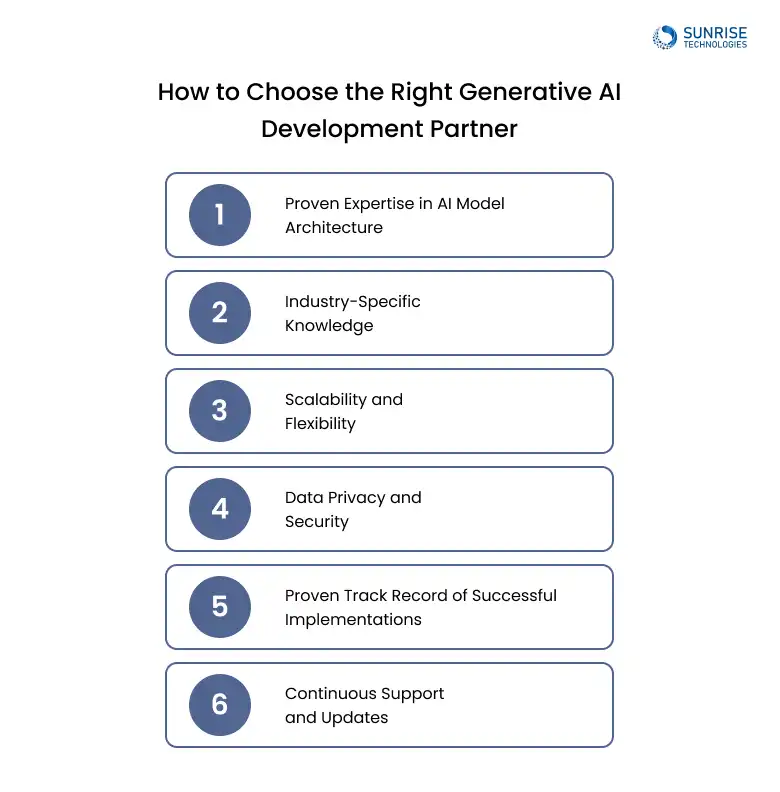
Look for partners with experience in advanced models like GPT, BERT, GANs, and Diffusion Models. Their ability to fine-tune these architectures for your specific needs shows their practical expertise in deploying AI solutions effectively.
Ensure your partner understands the unique challenges and regulations of your industry, whether it’s healthcare, finance, or retail. Their ability to navigate industry-specific standards, such as HIPAA or PCI DSS, ensures the solution is tailored and compliant.
Your partner should offer scalable solutions that grow with your business needs. Whether you’re handling increased data volume or expanding to new markets, flexibility in deployment and integration is crucial for long-term success.
Data security is non-negotiable, especially with sensitive customer data. Choose a partner who implements robust security measures, including encryption, secure API access, and compliance with industry standards like GDPR and HIPAA.
A partner with a strong portfolio of successful generative AI projects will be more likely to deliver impactful results. Look for case studies or testimonials showcasing their ability to solve real-world problems with generative AI.
AI is ever-evolving, so having a partner committed to ongoing support and system updates is essential. A good partner will ensure your AI models stay up to date with the latest advancements, improving performance over time.
Generative AI in 2025 is becoming foundational to digital transformation. Businesses are leveraging transformer-based architectures, large language models (LLMs), and diffusion models to automate workflows, enhance customer experiences, and generate high-value outputs like code, content, and design assets.
From fine-tuning pre-trained models like GPT, LLaMA, or Claude to integrating APIs into enterprise applications, organizations are embracing use cases ranging from automated report generation to intelligent assistants trained on proprietary data.
Looking to build your GenAI stack? Partner with top-tier Generative AI development companies like Sunrise Technologies, who bring deep expertise in model deployment, data pipelines, and end-to-end product integration. Let’s engineer intelligence that delivers measurable ROI.
Have bold ideas but need AI expertise? Our Generative AI specialists harness deep learning and NLP to craft intelligent, scalable solutions tailored to your vision.
Generative AI can enhance customer service by automating responses, personalizing interactions, and providing 24/7 support, leading to faster resolutions and improved customer satisfaction.
Generative AI models for business include Transformer-based models like GPT for text generation, GANs for image creation, and multimodal systems that combine data from various sources to provide more holistic solutions.
Generative AI can automatically generate high-quality content, including blog posts, social media updates, and marketing copy, saving time and ensuring consistency in messaging for businesses.
Common challenges include data privacy concerns, integration with existing systems, and the need for skilled resources. Overcoming these challenges requires selecting the right AI development partner and ensuring proper infrastructure.
When selecting a generative AI partner, consider their expertise in AI model architecture, industry-specific knowledge, ability to scale solutions, and commitment to data security and ongoing support.
Sam is a chartered professional engineer with over 15 years of extensive experience in the software technology space. Over the years, Sam has held the position of Chief Technology Consultant for tech companies both in Australia and abroad before establishing his own software consulting firm in Sydney, Australia. In his current role, he manages a large team of developers and engineers across Australia and internationally, dedicated to delivering the best in software technology.

